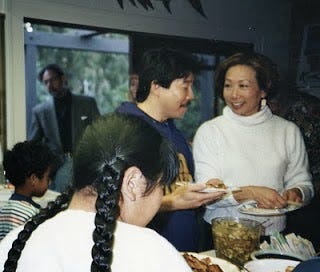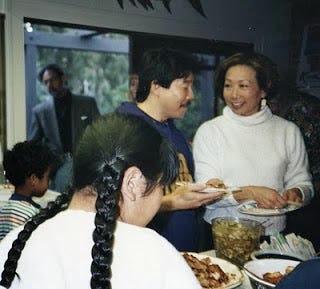On Lunar New Year, in keeping with our family’s tradition, I will be welcoming in the new year, not with our house packed with family and friends, like we did for more than three decades. Still, I’m honoring, bowing deep to cherished traditions. Remembrance weighs heavy on my mind, as it does for most mixed-race people seeking to retain racial and cultural identity.
Now I’m a grandmother, and we gather strength from our toes, rooted in soil memories, with our strong arms carrying baskets of culture.
Today I’m leaning back in time. It’s 1998. My kids are teenagers. Our Lunar New Year gatherings are part family reunion, part cultural revival. Our friends remove their shoes at the door. Sounds overlap in layers. The song Arriang and talking and laughter mixed with the clicking of sticks from the game Yut. We're celebrating Solnal-the first day of the first month by the lunar calendar. Most people think of this as Chinese New Year, but Koreans celebrate as well, and we have strong ties to Korean.
My hall table is piled high with wrapped packages, inexpensive items purchased at the dollar store for that long-standing tradition of giving a gift to each guest. The scent of garlic and sesame hang in the air like a spicy fog. I slide a baking sheet with dried seaweed out of the oven and spread sesame oil across the envelope-sized pieces.
"You are supposed to put the sesame oil on before you put it in the oven," my friend Jung Hee gasps. She pops a piece into her mouth. "Doesn't matter, it tastes good."
"The rice isn't cooking," I complain. Two of my friends who are very old elders; grandmothers with small wrinkled faces strain the excess water and get the massive rice cooker I've borrowed from the Korean church to cook a perfect pot of rice. I pull out a large pan filled with chop chae. "Is this alright?" I ask. I always feel a tiny bit worried when I cook Korean food for my Korean American friends. I hand a pair of thin metal chopsticks to one of the grandmothers. She tastes a bite, and nods her head in approval.
Duk kuk, the special soup made with rice cakes, simmers on my stove. And a group of teenage girls are gossiping in the back bedroom, while the boys play video games in the living room. It's okay. They are soaking up Korean culture by osmosis.
Meanwhile in the living room more game playing begins. Our silliest game is the javelin. We write our names on wooden chopsticks, stand behind a line, and toss them. Prizes (the wrapped packages from the dollar store) are given to everyone. My Korean friends, I've learned, like my Native American friends, love to gamble, so we always include a lively jest of Fifty/Fifty pulled from my own mixed-blood American Indian culture.
A treasured tradition of Korean Lunar New Year is getting new clothes; a traditional Korean hanbok. Wearing hanboks the little children line up, and one by one offer a sebe, a bow to elders, which is the first greeting to the elders of the year. Our elder-friends gathered, all with high-cheek rounded faces, are a blending of family and friends. Gloria, our eldest grandmother, wearing her turquoise beaded ear-rings, the pair she beaded last summer that play against her dancing eyes, is the first elder in the line and the littlest boys and girls began trotting up to her, and one by one they bend into a deep bow.
Each child who bows receives a red envelope containing a small amount of "lucky money." The word "money" draws the first teenage boy out of the den. He folds his lanky body into a bow with his nose touching the ground, and becomes an instant hero. The laughter draws out the teenage girls.
Throughout the evening my kid's outgrown hanboks are worn by my friends' children. Each year they become more stained and frayed from years of bending and bowing. Yet I treasure the memory more this way than if I'd kept them pressed clean in plastic on the top shelf of the closet.
Fiery in spirit and flamboyant, the kids swirl around the living room, their slightly oversized scarlet and fuchsia hanboks rippling, with rainbow sleeves shimmering in the light. My son joins the pageant, and slides around the dining room in his stocking feet. He has a smirk on his face and yet he is glowing and beaming with pride.
We try to prepare the food as authentically Korean as we can, and I will drive an hour in cross-town traffic to get mung beans to make pindaettok. To keep the doings simple, we ask each family invited to bring a panchan, a Korean side dish. My husband prepares an elaborate fish dish, and since it's not a meal without rice and soup we provide that too.
Two of my kids were born in South Korea in the late 1970s and early 80s. My son was a year old when we adopted him, and four years later we brought a ten-year old daughter into our family through foster care and adoption from Korea.
Remembrance weighs heavy on my mind, as it does for all American Indian mothers seeking to affirm and retain cultural identity. So naturally I wanted to give to my children what was given to me. I remember my grandmother’s words. “Child,” she said, “We’re American Indians, and they tried to scatter our cultures into odds and bits, yet Indian people are determined to keep our life ways alive.”
I wanted to make it possible for my kids to gather bits and pieces of Korean culture and braid it into our lives, and show them how to hold their heritage high.
While my son and my oldest daughter explored the constantly evolving questions of what it means to be Korean American, and my younger daughter who is Cherokee, Lenape, Seneca and Irish, grew increasingly more aware and diverse, my husband and I sank in roots in our local Korean community.
When our family first began embracing Korean ethnicity and braiding it into our lives, way back in in the early 1980s, we were careful to stay well within old-style traditional Korean cultural boundaries. However, after making numerous close bonds with friends in the Korean American community, I quickly discovered it's okay to play with various ways of honoring cultural traditions, and to put a modern-day personal spin on Korean Lunar New Year. What's important is to create rituals of intimate gathering with family and friends, sharing a Korean meal and good times together, so that our children will grow up holding a piece of Korean tradition in their hands and in their hearts.
When my kids were teenagers and the idea of hanging out at home was no longer at the top of their list of fun things to do on a Saturday night, we suggested they each invite a friend, or two or three, and our guest list grew.
One year, while caught in the throes of a winter season requiring my unremitting attention, I asked my kids, "Couldn't we make do with a smaller party this year?" All three gasped at once and said "But we like the big party." My son chimed in, "Didn't you know, it's our favorite holiday."
My attempt to peel back the layers and discover what this lunar new year gathering actually meant to him was brushed aside in a typical teenager manner. Then a kind of palpable energy hovered in his husky voice, "It just makes me happy, Mom, that's all."
Terra Trevor is an essayist, a memoirist, and a contributor to fifteen books. Of mixed descent, including Cherokee, Lenape, Seneca, German, with ties to Korean, her stories are steeped in themes of place and belonging, and are shaped and infused by her identity as a mixed-blood. She is the author of We Who Walk the Seven Ways: A Memoir (University of Nebraska Press).




